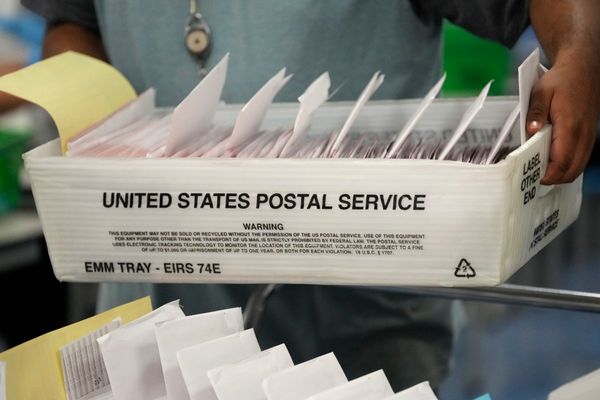Recent developments in the US presidential campaign have pushed the question of how to resolve the war in Ukraine war up the agenda. With a Republican presidential victory looking increasingly likely, reports suggest Donald Trump would quickly demand that Ukraine enter peace talks should he win November’s election.
His choice of running-mate – the outspoken opponent of US military assistance to Ukraine, JD Vance – has further increased the likelihood of this.
A recent poll in Ukraine showed 44% of Ukrainians want formal peace talks with Russia to begin, up from 23% in May 2023. But what would a just and stable long-term peace look like? Ukraine has set out its demands, including full withdrawal of Russian troops and the creation of a tribunal to prosecute Russian war criminals.
These are eminently reasonable. But it is also important to understand Russian grievances. This is not to excuse aggression – but Russia started the war, so understanding its reasoning is important to grasp why it occurred and how eventually to end it.
The Kremlin set out its complaints in a 2021 essay purportedly written by Vladimir Putin: On the Historical Unity of Russians and Ukrainians. If we cut through its dubious historical claims, the remaining grievances are largely traditional geopolitical issues about disputed territory, borders and minorities. These local, regional and national-scale issues are routinely encountered after the break-up of multi-ethnic empires such as the Soviet Union.
Putin’s essay refers to “Ukrainian neo-Nazis,” and he has repeatedly said that the “de-Nazification” of Ukraine is a goal of the invasion. The suggestion that Ukraine is overrun by fascists is nonsense. But government-mandated celebrations of Ukrainian nationalist Third Reich collaborators such as Stepan Bandera have caused outrage in Russia and beyond.
The toppling of Russian statues and their replacement with memorials to Ukrainian ultra-nationalists has also proved deeply contentious. This question of how the Communist period is remembered in public space is one that many east European states have faced and found ways to address. A future peace deal could defuse these tensions by allowing individual communities, at the local scale, to decide how they wish to remember the past and mark public space.
Language barriers
At the regional scale, a recurring complaint in Putin’s essay is that Russian-speaking minorities (especially in Ukraine’s eastern regions) have suffered discrimination under Kyiv’s laws on language and education. Promoting Ukrainian at the expense of minority languages, Putin argues, is problematic in a country “that is very complex in terms of its territorial, national and linguistic composition”.
Putin greatly exaggerates the threat to ethno-linguistic minorities. But non-partisan international bodies such as the United Nations, the Organization for Security and Co-operation in Europe OSCE and the European Centre for Minority Issues have also raised concerns about discrimination against minorities in Ukraine.
This challenge of how to promote the language and culture of a majority ethnic group while respecting ethnic diversity following independence is a recurring one. There are numerous creative ways to resolve it.
For example, in the 19th century, the Danish-German conflict over Schleswig-Holstein was seen as the classic unsolvable ethno-territorial dispute. The division of Schleswig between Germany and Denmark in a 1920 referendum left vulnerable and dissatisfied linguistic minorities on both sides of the new border. It was eventually solved by a model of non-territorial autonomy.
This meant that the two states agreed to respect the international boundary, but minorities were given the right to use their own languages for education, worship and cultural life. It’s a model that might usefully be reworked in Ukraine.
Question of boundaries
Finally, at the national scale, Russia has disputed Ukraine’s boundaries and has illegally annexed territories. Putin’s essay argues that these boundaries had been artificially manipulated by the Bolsheviks and were “never seen as state borders”.
Historical scholarship would agree that the Soviet Union’s boundaries – like virtually any modern state boundary – were to an extent artificial. But that’s no excuse to contest them today. Russia has repeatedly recognised Ukraine’s boundaries, most clearly in a 2003 treaty. There have been fewer than a dozen successful examples of boundary changes by force since 1945 and the UN can’t allow this precedent.
But there are many ways in which the either/or logic of state sovereignty – in other words, “this land is either mine or yours” – can be adapted to help overcome these issues. One is the creation of sovereign regions, such as Åland Islands in the Baltic Sea. Historically Swedish, they ended up Finnish after the first world war.
Now a demilitarised, self-governing territory, they fall under Finnish authority but govern their own internal affairs. Such a solution could be adapted for eastern areas of Ukraine that Russia has illegally annexed.
Another sticking point is likely to be Crimea, which has historically been closely identified with Russia. This could be resolved through “territorial leasing”, where one state leases land to another. For example, Russia currently leases its Baikonur space centre from Kazakhstan. Kazakhstan exercises sovereignty over the city, but it is subject to Russian jurisdiction and the head of the city’s administration is appointed by the presidents of the two countries. Ukraine could lease Crimea to Russia, with both states involved in its joint administration.
The Russia-Ukraine war can’t be reduced to any single factor such as geography. A peace deal will need to address issues including war crimes, reparations and the return of abductees. It will also require new geopolitical arrangements guaranteeing the security of both Russia and Ukraine. Given previous broken Russian promises to Ukraine, and the bitter legacy of its naked aggression, a just and lasting peace like this will be hard to achieve.
But geographical issues will need tackling as stepping stones towards a settlement. The good news is that there are plenty of successful examples from around the world showing how this can be done.
Nick Megoran does not work for, consult, own shares in or receive funding from any company or organisation that would benefit from this article, and has disclosed no relevant affiliations beyond their academic appointment.
This article was originally published on The Conversation. Read the original article.







